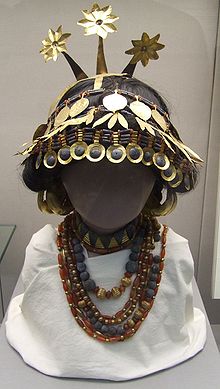| Puabi 𒅤𒀜 | |
|---|---|
| Queen of Ur | |
 | |
| Reign | fl. c. 2600 BCE |
| House | First Dynasty of Ur |


Puabi (Akkadian: 𒅤𒀜 pu3-AD or Pu-abi "Orchard of my father"), also called Shubad or Shudi-Ad due to a misinterpretation by Sir Charles Leonard Woolley, was an important woman in the Sumerian city of Ur, during the First Dynasty of Ur (c. 2600 BCE).[4] Commonly labeled as a "queen", her status is somewhat in dispute, although several cylinder seals in her tomb, labeled grave PG 800 at the Royal Cemetery at Ur,[5] identify her by the title "nin" or "eresh", a Sumerian word denoting a queen or a priestess. Puabi's seal does not place her in relation to any king or husband, possibly indicating that she ruled in her own right.[6] It has been suggested that she was the second wife of king Meskalamdug.[5] Although little is known about Puabi's life, the discovery of Puabi's tomb and its death pit reveals important information as well as raises questions about Mesopotamian society and culture.[7]
- ^ British Museum notice WA 121544
- ^ Crawford, Harriet (2013). The Sumerian World. Routledge. p. 622. ISBN 9781136219115.
- ^ Anthropology, University of Pennsylvania Museum of Archaeology and; Hansen, Donald P.; Pittman, Holly (1998). Treasures from the Royal Tombs of Ur. UPenn Museum of Archaeology. p. 78. ISBN 9780924171550.
- ^ Diakonoff, I. M. (2013). Early Antiquity. University of Chicago Press. pp. 78–79. ISBN 9780226144672.
- ^ a b Reade, Julian (2003). Art of the First Cities: The Third Millennium B.C. from the Mediterranean to the Indus. Metropolitan Museum of Art. p. 96. ISBN 978-1-58839-043-1.
- ^ "Queen Puabi's Headdress from the Royal Cemetery at Ur - Penn Museum". www.penn.museum. Retrieved 2019-03-28.
- ^ Durn, Sarah, The Most Lavish Mesopotamian Tomb Ever Found Belongs to a Woman, Atlas Obscura, February 10, 2022 with an image of adornment found on Puabi
